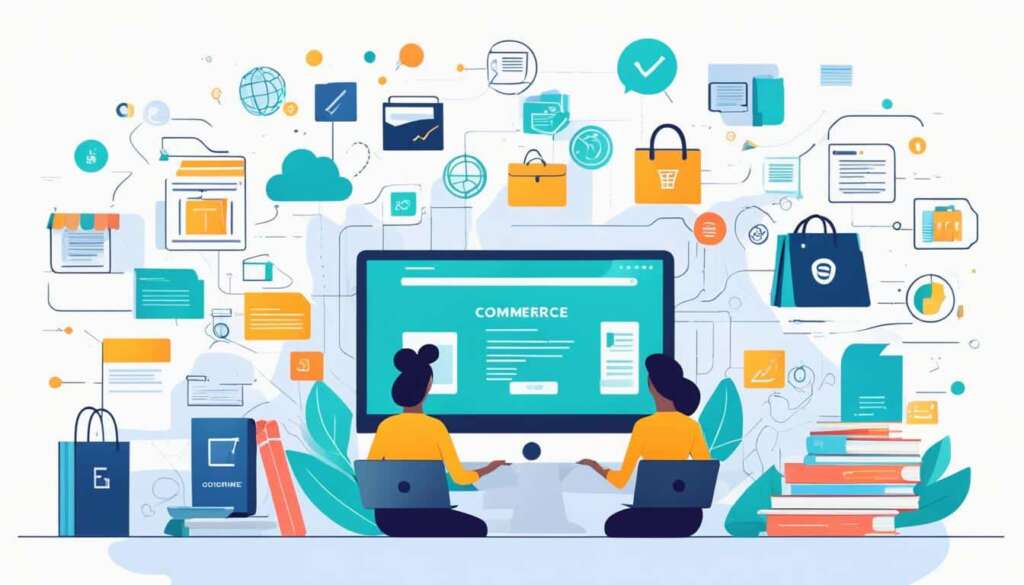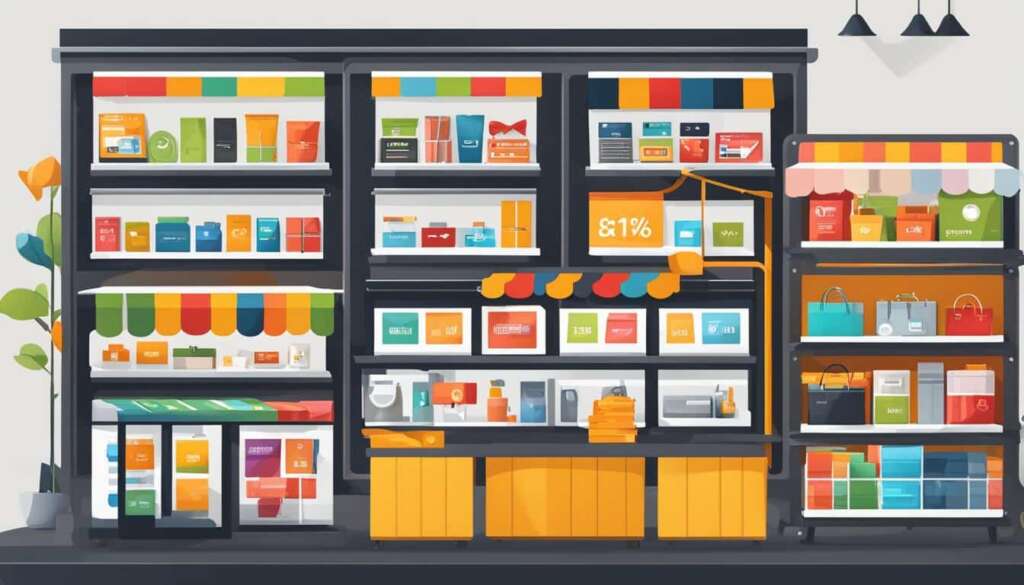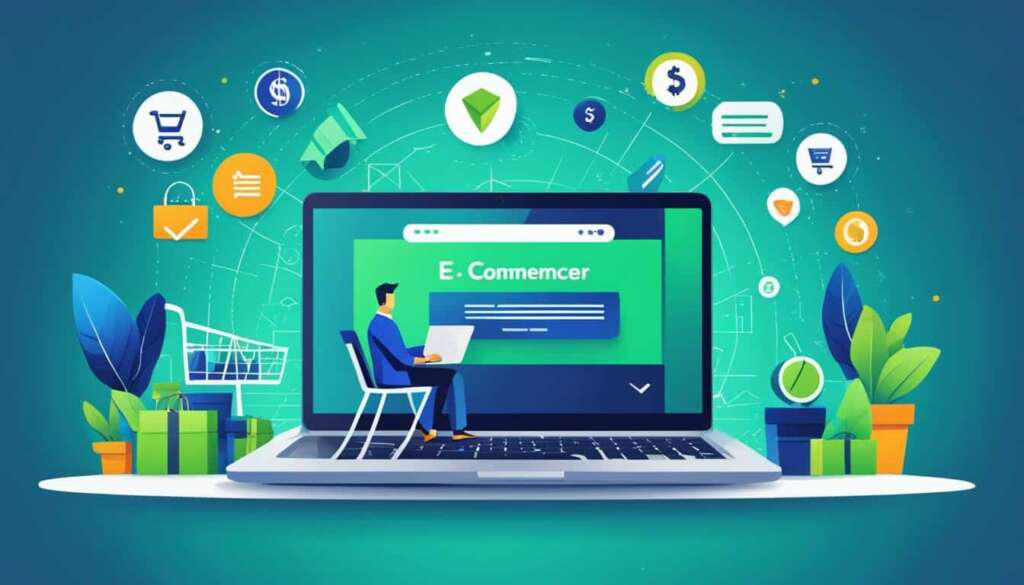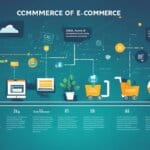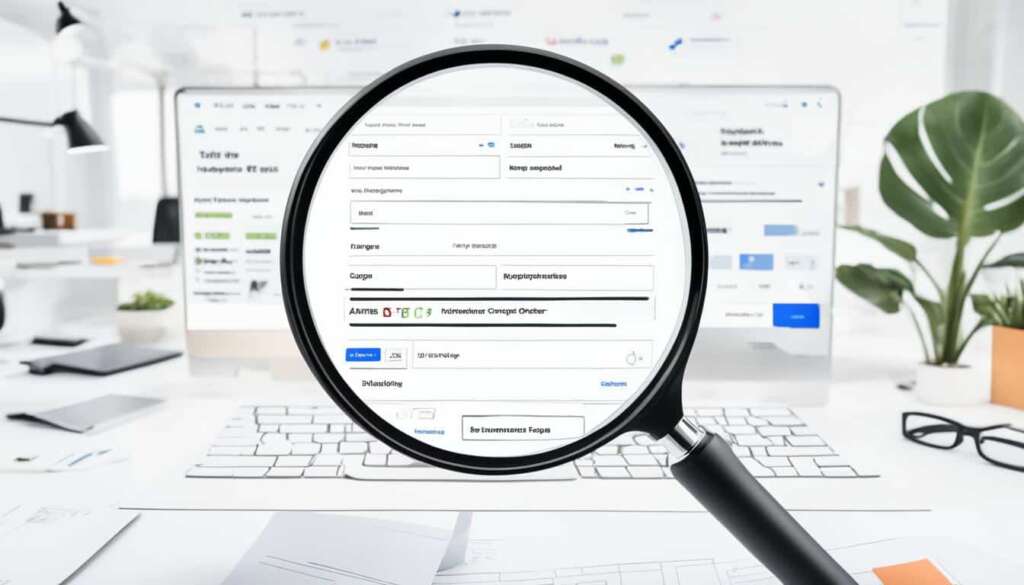Table of Contents
Setting up an ecommerce store to become a successful entrepreneur can be challenging, but with the right strategies, you can increase your e-commerce sales and build a thriving online business. In today’s digital age, having a strong online presence is crucial to tap into the vast online retail potential and reach a global audience. Expertly designed e-commerce websites are essential for attracting customers, showcasing products, and providing a seamless shopping experience.
In this article, we will explore 20 effective ways to boost your sales and maximize the potential of your e-commerce website. From targeted pricing to building an email list, from social media promotion to scarcity tactics, we will delve into actionable strategies that have been proven to deliver results. By implementing these strategies, you can enhance your online retail potential and achieve success in the competitive e-commerce market.
To get started, let’s dive into the first strategy: setting targeted pricing to increase your e-commerce sales.
Set Targeted Pricing to Increase E-commerce Sales
One effective way to increase your e-commerce sales is by setting targeted pricing. By analyzing your website traffic using IP geolocation, you can offer specialized pricing based on the data you have. This allows you to optimize prices for different regions, taking into account tax rates and other geographic pricing dynamics.
Additionally, you can use IP data to set up geo-targeted matches, offering products that align with the preferences of customers from specific regions. This personalized approach can lead to happier customers and increased profit margins, ultimately boosting your e-commerce sales.
Targeted pricing enables you to cater to the needs of specific regions, ensuring that your prices are competitive and attractive to potential customers. By utilizing IP geolocation, you can identify the location of your website visitors and tailor your pricing accordingly. For example, if you have a customer in a country with a lower cost of living, you can offer them a discounted price. On the other hand, if you have customers in a region where your product is in high demand, you have the opportunity to increase your prices and maximize your profit margins.
Optimize Prices for Different Regions
When optimizing prices for different regions, it is essential to consider various factors such as tax rates, local purchasing power, and economic conditions. By adjusting your prices accordingly, you can ensure that your products remain competitive and affordable in each specific market.
Here is an example of how targeted pricing can be implemented:
| Region | Tax Rate | Product Price |
|---|---|---|
| United Kingdom | 20% | £49.99 |
| United States | 0% | $59.99 |
| Australia | 10% | $99.99 |
In this example, the product price is optimized for each region, taking into account the respective tax rates. By offering a competitive price in each region, you can attract customers and increase your e-commerce sales.
Geo-Targeted Matches for Personalized Shopping Experience
Another way to leverage targeted pricing is by setting up geo-targeted matches. By analyzing the preferences and purchasing behavior of customers from specific regions, you can offer products that align with their interests and buying habits.
“We carefully analyze customer preferences and use IP geolocation data to offer personalized recommendations to our customers. By tailoring our product offerings to specific regions, we have seen a significant increase in conversions and customer satisfaction.” – John Smith, CEO of XYZ E-commerce Store
This approach not only enhances the shopping experience but also helps you increase your e-commerce sales by presenting customers with products that are highly relevant to their needs and interests.
Implementing targeted pricing and geo-targeted matches can have a significant impact on your e-commerce sales and profit margins. By optimizing prices for different regions and offering personalized product recommendations, you can attract more customers, boost conversions, and ultimately increase your revenue.
Build an Email List for Better E-commerce Sales
Building an email list is a powerful strategy for increasing e-commerce sales. Email marketing allows you to target and retarget customers at a much better conversion rate than social media platforms.
By incentivizing customers to provide their information, such as offering discounts or special incentives, you can compile an expansive email portfolio. This email list becomes a valuable asset that you can use to nurture relationships with your target customers and drive sales.
One effective way to encourage customers to join your email list is by creating a newsletter that provides exclusive content, early access to sales, and special promotions. This entices customers to sign up and stay engaged with your brand.
Personalizing your emails is also crucial for increasing e-commerce sales. By using personalized greetings and segmenting your email lists based on customer preferences, you can provide relevant and targeted content that resonates with your customers. This level of personalization builds rapport and trust, making customers more likely to make a purchase.
Furthermore, it’s important to exclude existing subscribers from receiving old emails, as this can lead to customer dissatisfaction. By regularly reviewing and updating your email list, you ensure that your communications are timely and relevant.
To ensure email deliverability and professionalism, consider using email hosting for your small business. This helps maintain a high deliverability rate and ensures that your emails land in customers’ inboxes, rather than getting lost in spam folders.
Key Benefits of Building an Email List:
- Direct communication channel with your target audience
- Higher conversion rates compared to social media platforms
- Opportunity to personalize emails for increased engagement
- Ability to segment your email lists and tailor content to customer preferences
- Cost-effective marketing strategy
Building an email list is like having a direct line of communication with your most loyal customers. By personalizing your emails and providing valuable content, you can nurture these relationships and drive more sales. – E-commerce Expert
To summarize, building an email list is a vital component of a successful e-commerce strategy. It allows you to establish direct communication with your target customers, personalize your emails, and drive higher conversion rates. By leveraging the power of email marketing, you can effectively boost your e-commerce sales and achieve greater success in the online marketplace.
Promote Your E-commerce Store on Social Networks
Creating promotional campaigns for different social networks is crucial for boosting your e-commerce sales. Establishing a presence across social media platforms helps drive traffic and sales to your e-commerce store and allows you to engage with audiences, tap into influencer networks, and build brand awareness.
Understanding your target audience’s habits on these platforms is essential for success. Each social media network has its unique audience, strengths, and weaknesses. By tailoring your promotional campaigns to each platform, you can effectively reach and engage your target customers.
Utilize social media marketing tools to streamline your efforts and maximize your e-commerce sales:
- Use scheduling tools to plan and automate your social media posts, ensuring consistent and timely content delivery.
- Take advantage of social media listening tools to monitor conversations and trends related to your brand, products, and industry.
- Leverage analytics tools to track the performance of your social media campaigns, measure engagement, and optimize your strategies.
Engaging with your audience is key to building brand awareness and driving sales. Encourage user-generated content by running creative contests or campaigns that involve your customers. Respond promptly to comments, feedback, and messages to foster a sense of community and trust.
Tap into Influencer Networks
Collaborating with influencers in your niche can significantly boost your e-commerce sales. Influencers have established credibility and a loyal following, making them influential voices in their respective communities.
“Partnering with influencers allows you to tap into their fan base and leverage their influence to promote your products. It’s a powerful way to reach a wider audience and build social proof,” says Emily Thompson, a social media marketing expert.
Harness the power of influencer marketing by identifying influencers that align with your brand values and target audience. Reach out to them with personalized and compelling collaboration proposals. Whether it’s through sponsored posts, product reviews, or affiliate partnerships, influencers can help amplify your brand message and drive traffic to your e-commerce store.

Monitor and Engage
Consistently monitoring your social media platforms is crucial to stay up-to-date with customer feedback, inquiries, and emerging trends. Responding promptly and positively to comments and messages shows your commitment to exceptional customer service.
Here are some tips to effectively monitor and engage on social media:
- Set up notifications for mentions, comments, and messages so you can promptly respond.
- Monitor relevant hashtags and join relevant conversations to expand your reach and engage with potential customers.
- Show appreciation for positive feedback and address negative feedback in a constructive and empathetic manner.
Building strong relationships with your audience contributes to brand loyalty and can lead to repeat purchases and referrals.
Build Brand Awareness
Creating captivating and shareable content is essential for building brand awareness on social media. Develop a content strategy that aligns with your brand identity and resonates with your target audience.
“Sharing informative, entertaining, and visually appealing content is key to capturing your audience’s attention and making a lasting impression,” advises Sarah Davis, a social media strategist.
Consider using a mix of content formats, such as images, videos, infographics, and blog posts, to cater to different preferences and optimize engagement.
| Social Media Platform | Strengths | Weaknesses |
|---|---|---|
| Large user base, robust advertising capabilities, diverse content formats | Declining organic reach, high competition for attention | |
| High visual appeal, ideal for showcasing products and lifestyle, influencer marketing potential | Limited link options, younger audience skew | |
| Real-time engagement, effective for news, customer service, and industry conversations | Character limit, fast-paced nature | |
| Professional networking, B2B marketing opportunities, thought leadership promotion | Niche audience, less content virality |
By understanding the strengths and weaknesses of each platform, you can tailor your content and promotional strategies accordingly, maximizing your brand’s visibility and reach.
Promoting your e-commerce store on social networks is a vital component of your overall marketing strategy. Utilize the power of social media marketing tools, engage with your audience, tap into influencer networks, and build brand awareness to drive traffic, engage audiences, and boost your e-commerce sales.
Use Scarcity Tactics to Drive E-commerce Sales
Incorporating scarcity tactics into your e-commerce strategy can create a sense of urgency that drives customers to make immediate purchases. By leveraging the fear of missing out (FOMO), scarcity tactics can effectively increase your e-commerce sales and create a buzz around your products.
One effective scarcity tactic is to host flash sales, offering significant discounts for a limited time. This creates a sense of exclusivity and encourages customers to take advantage of the time-limited offer. Countdown timers are another powerful tool to instill urgency. By prominently displaying countdown timers during sales, you create a visual reminder of the limited availability, motivating customers to act quickly before the opportunity expires.
Highlighting limited availability is also a valuable scarcity tactic. By indicating that there are only a few items remaining or that there is limited stock, you tap into customers’ fear of missing out and ignite the desire to secure the product before it’s gone. This technique creates a sense of demand and urgency, leading to increased e-commerce sales.
Another effective scarcity tactic is offering limited-time free shipping offers. By attaching a deadline to free shipping, you create a compelling incentive for customers to complete their purchase. This strategy not only drives sales but also removes any shipping-related barriers that could hinder the conversion process.
When implementing scarcity tactics, it’s important to strike the right balance. While creating a sense of urgency is valuable, it’s crucial to maintain transparency and authenticity. Be honest about the limited availability and ensure that customers understand the terms and conditions of the scarcity tactics you employ.
By using scarcity tactics such as flash sales, countdown timers, limited availability notices, and free shipping offers, you can effectively drive e-commerce sales and create a sense of urgency that compels customers to take action. Incorporate these tactics into your e-commerce strategy and watch as your sales soar.
Scarcity Tactics
| Scarcity Tactic | Description |
|---|---|
| Flash Sales | Time-limited sales with significant discounts to create a sense of exclusivity and urgency. |
| Countdown Timers | Visual reminders of limited availability during sales, motivating customers to act quickly. |
| Limited Availability Notices | Highlighting limited stock or remaining items to tap into customers’ fear of missing out. |
| Free Shipping Offers | Time-limited offers for free shipping, removing barriers to purchase and compelling customers to buy. |
Conclusion
Successfully increasing e-commerce sales requires a strategic combination of effective strategies. By implementing targeted pricing, building an email list, promoting your e-commerce store on social networks, using scarcity tactics, and optimizing the checkout process, you can significantly boost your online retail potential and achieve success in the highly competitive e-commerce market.
Continuously testing and optimizing your approach is crucial to stay ahead of the competition and maximize your sales. Remember, the e-commerce industry is constantly evolving, so it is important to adapt your strategies to changing trends and customer preferences.
By utilizing the right strategies, you can unlock the full potential of your online business and achieve long-term success in the e-commerce industry. So, make sure to implement these proven tactics and watch your e-commerce sales soar, leading your business to online success.
FAQ
How can targeted pricing help increase e-commerce sales?
Targeted pricing involves analyzing website traffic using IP geolocation to offer specialized pricing based on regions, tax rates, and other geographic pricing dynamics. This personalized approach can lead to happier customers and increased profit margins, ultimately boosting e-commerce sales.
Why is building an email list important for e-commerce sales?
Building an email list allows for targeted email marketing, which has a better conversion rate than social media platforms. By incentivizing customers to provide their information and personalizing emails based on customer preferences, e-commerce sales can be increased.
How can I promote my e-commerce store on social networks?
You can promote your e-commerce store on social networks by creating promotional campaigns tailored to each platform, engaging with audiences, tapping into influencer networks, and building brand awareness. Utilize social media marketing, listening, and scheduling tools to maximize your e-commerce sales.
What are scarcity tactics and how can they boost e-commerce sales?
Scarcity tactics create a sense of urgency that drives customers to make immediate purchases. Hosting flash sales, adding countdown timers, displaying limited availability, and offering limited-time free shipping can create a perception of high demand and increase e-commerce sales.
What are some effective strategies to boost e-commerce sales?
Effective strategies to boost e-commerce sales include targeted pricing, building an email list, promoting the e-commerce store on social networks, using scarcity tactics, and optimizing the checkout process. By implementing these strategies, online retail potential can be maximized and long-term success in the e-commerce industry can be achieved.


